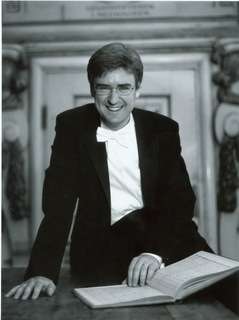|
Back
Sparks Fly in Gutsy Performances Houston
Jones Hall
04/17/2009 - & April 18*, 19
Carl Nielsen: Saul and David - Prelude to Act II
John Adams: Violin Concerto
Johannes Brahms: Symphony No. 1 in C Minor, Op. 68
Leila Josefowicz (violin)
Houston Symphony Orchestra, Thomas Dausgaard (conductor)

Thomas Dausgaard (© Marianne Grøndahl)
This was a truly memorable concert in Jones Hall. While the repertoire and interpretations might not have been to everybody’s tastes, there can be no doubt that Dausgaard took a distinctive artistic stance and stuck to his guns.
The Danish conductor opened the night with a taste of his homeland. Nielsen is rarely played in Jones Hall, so anything we get is welcome, but this prelude is not one of the composer’s more interesting works. Dausgaard, conducting from memory, drew brilliant playing from the orchestra’s brass in the outer segments of the work. The performance was slightly marred by shoddy woodwind playing in the second subject, but overall it was a pleasant opener. One hopes that the conductor will bring something truly substantial and masterful from Nielsen’s pen to Houston.
This prologue gave no hint of the intensity that would fill the remainder of the program. In recent years, Canadian violinist Leila Josefowicz has become a strong advocate of new music. Her charismatic stage presence held the audience’s attention before the first downbeat of John Adams’ splendid Violin Concerto began. Throughout the work, there was a magical symbiosis on stage. Dausgaard was the effortless liaison between Josefowicz and the orchestra, negotiating the fluid tempo changes of the ever-ascending opening movement perfectly. The second movement chaconne is all about subtle shades of color, and the orchestra’s strings were excellent, admirably matching Josefowicz’s vast range of timbres. The final “Toccare” is one of those movements where interpretation of the score is almost a moot point. It’s basically about the performers accurately executing the never-ending stream of notes written on the page. Josefowicz plays the movement like a rock star, digging in gallantly and clearly enjoying the ride on top of the orchestra’s ebb and flow. A few minor coordination problems aside, it was a thrilling rendition and garnered an immediate, appreciative standing ovation from the audience.
At the risk of lapsing too far into Texas cliché, I can sum up what took place after intermission in one sentence: “This ain’t your momma’s Brahms’ first.” By far the fieriest, gutsiest, and most operatic rendition of the piece I’ve ever heard, Dausgaard pushed the limits in terms of tempi and dynamic contrasts and made a Romantic warhorse sound undeniably timely and thrilling.
Dausgaard was audacious from the get go, giving the downbeat before the applause greeting his arrival onstage had subsided. The tempo of the first movement’s introduction predicated a taut, quick overall interpretation. The main Allegro was played at a very energetic pace, and Dausgaard didn’t let up one bit until the very end of the second theme. As a listener, I was already out of breath before the exposition repeat. Allowing the pulse to slow during the development set the stage for a thrilling rollercoaster ride into the recapitulation, delivered with venomous conviction by the orchestra, the horns and timpani almost maliciously cutting through the texture.
The opening of the Andante sostenuto provided momentary relief, but Dausgaard again pushed and pulled the tempo throughout the movement at will. There seemed to be a slight lack of coordination in the oboe’s meandering solo above syncopated strings, but this was quickly remedied when repeated by the clarinet. Acting Concertmaster Eric Halen’s solos towards the end might have benefited from slightly less vibrato, but were convincingly phrased and floated clearly above the orchestral texture. The timpani’s underlying heartbeats were brought out nicely.
The third movement was generally too fast, sounding more like an Allegro giusto than Un poco allegretto e grazioso. One lost a sense of contrast in this movement, the bold trumpet contributions almost Wagnerian in their bravado. It was indeed a distinctive reading of the movement, but didn’t convince.
The opening of the fourth movement was again too fast to be truly Adagio, but there were many imaginative touches in Brahms’ orchestration that were emphasized. One notable example was the scurrying string descent right before the Più Andante, where the divisi violins exaggerated their entries and provided a wonderful antiphonal affect that doesn’t typically come across. The great horn solo was oddly phrased, with the second horn player accenting his entry instead of swelling to meet the principal horn’s dynamic level and make a continuous phrase out of the line. One wonders if Dausgaard forgot about the non troppo after the Allegro marking of the movement proper, as he unabashedly proceeded with an unusually quick tempo. The argument could be made that the resulting alla breve feel for the remainder of the piece wasn’t quite what Brahms had in mind, but the equally convincing rebuttal would be that this was a fresh, hair-raising reassessment of a movement typically taken too slowly. Regardless, the movement was clearly goal-oriented, every phrase pushing nearer and nearer to the triumphant final brass chorale, which was gloriously balanced from top to bottom and hyperbolically stretched by the conductor. After this, all the stops were pulled out in a high-speed coda that immediately brought the audience back to its feet.
This is the type of music-making that is rare in Jones Hall. There was a constant sense of personal engagement from all performers throughout the program. Both Josefowicz and Dausgaard advocated unfamiliar works close to their hearts and the orchestra and audience had no choice but to be drawn in. There was much chatter as the crowd left about what had just transpired onstage, which is precisely what a great performance should engender. One hopes that these two fantastic performers return soon to Houston.
The Houston Symphony
Marcus Karl Maroney
|